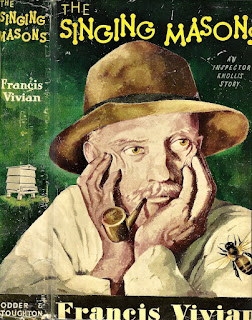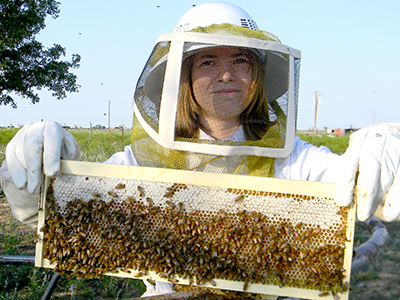I will
remember the stuff about bees in The
Singing Masons
long after I've forgotten the plot and the human characters and the
name of the author. This is not to say the murder mystery and the
people and the writing were merely so-so. All were top-notch (to my
admittedly less-than-sophisticated taste). The
bees play a marquee role, and
yet they’d not have had
the chance to
steal the show were it not for the honey trap promise
of
an intriguing human crime mystery. Were
the book only about bees
I doubtless never would know that half of
them
buzz off with a newly hatched queen to start a new colony, leaving
the old gal to rule the half that stay behind with her in the
original hive. It’s what they do.
It helps my
suspension of disbelief in this work of fiction that a copy of The
Singing Masons
resides at Cornell University in “one of the largest and most
complete apiculture libraries in the world,” and that Vivian was
himself a dedicated beekeeper. This I learned also in the book’s
Dean Street Press edition from its introduction by crime fiction
historian Curtis Evans.
Vivian,
born Arthur Ernest Ashley, was writing for newspapers and magazines
when he began cranking out novels in 1937. Published in 1950, Singing
Masons
is the sixth of ten in a series featuring Scotland Yard Inspector
Gordon Knollis. In Singing
Masons,
Knollis is brought in to assist Clevely
Borough Inspector Wilson investigating the discovery of a month-long
missing local lothario in an abandoned well hidden under a beehive.
The list of suspects in this small community is not long:
the victim’s fiancé,
whom he had ditched a day before he disappeared, her lawyer father, a
couple of his married sexual conquests, including a cousin who has
slapped him publicly only days before he disappeared, and her
husband. The usual motives are in play, including blackmail, money,
and scandal—intertwined and separately. Thoroughly unlikable, he
was, except evidently to certain women. The kind of jerk I just might
have pushed alive into the well myself, especially knowing he had a
cardboard container of calcium cyanide in his pocket that would
release lethal gas when activated by water. Cyanide, I can note
without spoiling any plot twists, he’d been planning to use on one
of the suspects! Had I done so—pushed the blackguard into the
well—presumably without the proverbial airtight alibi, local
Inspector Wilson could easily have solved the mystery all by himself,
as I would not have had the pluck to cover the well with an empty
beehive. Then again, everyone except those who didn’t know bees
knew the property’s recently deceased owner loathed bees.
Ah,
“The bees! The bees!” as Nicolas Cage wailed in The
Wicker Man.
Singing masons, as Shakespeare called them in Henry
V:
For so work the honey-bees.
Creatures that, by a rule in nature, teach the act of order to a
peopled kingdom. They have a king, and officers of sorts. Where some,
like magistrates, correct at home, others, like merchants, venture
trade abroad. Others, like soldiers, armed in their stings, make boot
upon the summer’s velvet buds, which pillage they with merry march
bring home to the tent-royal of their emperor, who, busied in his
majesty, surveys the singing masons building roofs of gold. The civil
citizens kneading up the honey. the poor mechanic porters crowding in
their heavy burdens at his narrow gate. The sad-eyed justice with his
surly hum delivering o’er to executors pale the lazy yawning drone.
Old Heatherington, the local
bee guru, offers a more vivid, if less poetic description. Watching
the bees at one of his hives reminds him, he tells us, “of a group
of village women preparing for an annual outing from the chapel. Some
trotted from the interior of the hive, seemed to chat with other
bees, and hurried back indoors as if they’d forgotten something, or
had a message to leave.
“Others
wiped their faces as if dabbing a final touch of powder on a shiny
spot. Others took off to circumnavigate the hive and land again with
weather reports. All were waiting for the signal to leave their home
and go out into the world to found a new colony, obeying the primal
order that all living things shall endure, shall multiply, and
endeavor to cover the earth.”
To
me that is the greater mystery, of much more fascination than who
killed the village cad and why. Puzzles can be fun for a little
while, diverting the mind from the predictable of diurnal duties. But
I’m retired from the harness, and my attention now wanders freely
from frivolous precisions. I simply don’t care whether an alibi
crumbles because the Sussex Bank clock said nine-oh-five when the
suspect insists it said nine-thirty, or when the TV show he/she
claims to have been watching when the dastardly deed was performed
had been pre-empted by a public service announcement from Ten Downing
Street. Or maybe I do care, a little, but let it slip past me in a
narrative that distracts my eye like a sleighting hand hidng a card
trick. And I do notice the obvious tricks, but feel cheated when it
becomes obvious I was supposed
to see the obvious trick that really has no bearing on the case. I
possess the patience level of the jigsaw puzzle solver who snips a
corner off an infuriating piece or hammers it with his fist to make
it fit in the damnable space where it should but doesn’t belong.
Mystery novels can do that to me. At some point I tire of the
detecting, and just want to see some schmuck I’ve sort of suspected
all along get what’s coming to him. Or her.
With Inspector Knollis, tho, I
rather enjoyed watching him check this and check that, say this and
that and some more of this as he worries himself and poor Inspector
Wilson half to death inching his way incrementally toward the wrong
suspect, until…
Here’s
a fine example of what I’m trying to say, his theory of detection:
“The facts of a murder case are like the lines of a poem or
song—they make sense only if you get them in the right order.”
And
this:
“It was seldom Gordon Knollis evolved a theory early in the course
of an investigation. His method was to seek a pattern in the events
surrounding the murder, a pattern which suggested, if no more, the
causal factors, and a pattern in which the murder was the focal
point.
“The
murder itself, despite its sensational nature, was not the vital
factor in a case as Knollis saw it; rather was it the bubble in a
swamp telling of long-repressed forces beneath the surface, the
eruption telling of poisons circulating through the apparently
healthy system, the molehill indicating the runs and tunnels hidden
from the eye.”
In this case one might add,
follow the bees.
[For
more Friday's Forgotten Books check the links on Patti
Abbott's unforgettable blog]



No comments:
Post a Comment